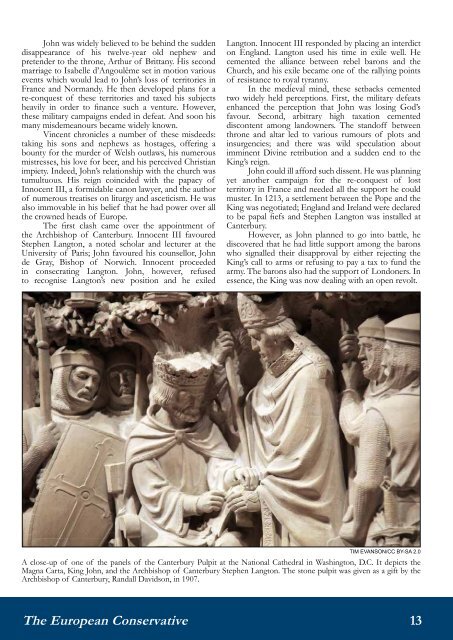CONSERVATIVE
eurocon_12_2015_summer-fall
eurocon_12_2015_summer-fall
- No tags were found...
Create successful ePaper yourself
Turn your PDF publications into a flip-book with our unique Google optimized e-Paper software.
John was widely believed to be behind the sudden<br />
disappearance of his twelve-year old nephew and<br />
pretender to the throne, Arthur of Brittany. His second<br />
marriage to Isabelle d’Angoulême set in motion various<br />
events which would lead to John’s loss of territories in<br />
France and Normandy. He then developed plans for a<br />
re-conquest of these territories and taxed his subjects<br />
heavily in order to finance such a venture. However,<br />
these military campaigns ended in defeat. And soon his<br />
many misdemeanours became widely known.<br />
Vincent chronicles a number of these misdeeds:<br />
taking his sons and nephews as hostages, offering a<br />
bounty for the murder of Welsh outlaws, his numerous<br />
mistresses, his love for beer, and his perceived Christian<br />
impiety. Indeed, John’s relationship with the church was<br />
tumultuous. His reign coincided with the papacy of<br />
Innocent III, a formidable canon lawyer, and the author<br />
of numerous treatises on liturgy and asceticism. He was<br />
also immovable in his belief that he had power over all<br />
the crowned heads of Europe.<br />
The first clash came over the appointment of<br />
the Archbishop of Canterbury. Innocent III favoured<br />
Stephen Langton, a noted scholar and lecturer at the<br />
University of Paris; John favoured his counsellor, John<br />
de Gray, Bishop of Norwich. Innocent proceeded<br />
in consecrating Langton. John, however, refused<br />
to recognise Langton’s new position and he exiled<br />
Langton. Innocent III responded by placing an interdict<br />
on England. Langton used his time in exile well. He<br />
cemented the alliance between rebel barons and the<br />
Church, and his exile became one of the rallying points<br />
of resistance to royal tyranny.<br />
In the medieval mind, these setbacks cemented<br />
two widely held perceptions. First, the military defeats<br />
enhanced the perception that John was losing God’s<br />
favour. Second, arbitrary high taxation cemented<br />
discontent among landowners. The standoff between<br />
throne and altar led to various rumours of plots and<br />
insurgencies; and there was wild speculation about<br />
imminent Divine retribution and a sudden end to the<br />
King’s reign.<br />
John could ill afford such dissent. He was planning<br />
yet another campaign for the re-conquest of lost<br />
territory in France and needed all the support he could<br />
muster. In 1213, a settlement between the Pope and the<br />
King was negotiated; England and Ireland were declared<br />
to be papal fiefs and Stephen Langton was installed at<br />
Canterbury.<br />
However, as John planned to go into battle, he<br />
discovered that he had little support among the barons<br />
who signalled their disapproval by either rejecting the<br />
King’s call to arms or refusing to pay a tax to fund the<br />
army. The barons also had the support of Londoners. In<br />
essence, the King was now dealing with an open revolt.<br />
TIM EVANSON/CC BY-SA 2.0<br />
A close-up of one of the panels of the Canterbury Pulpit at the National Cathedral in Washington, D.C. It depicts the<br />
Magna Carta, King John, and the Archbishop of Canterbury Stephen Langton. The stone pulpit was given as a gift by the<br />
Archbishop of Canterbury, Randall Davidson, in 1907.<br />
The European Conservative 13


